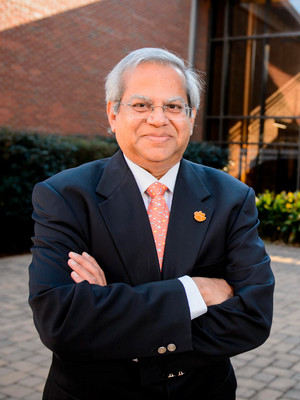Rajendra K. Bordia

George J. Bishop, III Chair Professor of Ceramics and Materials Engineering
Phone: (864) 656-5228
Office: 213 Olin
E-mail: rbordia@clemson.edu
Overview
Professor Bordia is the George J. Bishop, III Endowed Chair Professor of Ceramics and Materials Engineering. He has served as the Chair of the Materials Science and Engineering Department at Clemson University (2013-2019). Before joining Clemson in 2013, he was a faculty member in the Materials Science and Engineering Department at the University of Washington (UW). From 1998 to 2005, he was the Chairman of his Department at UW. He started his career as a Research Scientist in the Central Research and Development of DuPont Co. from 1986 to 1991. He has also had Visiting/Guest Professor appointments at the Indian Institute of Technology, Kanpur, India; Indian Institute of Science, Bangalore, India; Indian Institute of Technology, Gandhinagar, India and Friedrich-Alexander Universität, Erlangen-Nürnberg, Germany. Prof. Bordia received his undergraduate degree from the Indian Institute of Technology, Kanpur and his M.S. and Ph.D. from Cornell University in Materials Science and Engineering.
Prof. Bordia’s research is at the intersection of materials and mechanics and is focused on fundamental and applied studies in the processing and properties of complex material systems for energy, environmental, and medical applications. Current emphasis is on ceramics, composites, multilayered, and porous materials. He has authored or co-authored over 170 peer-reviewed technical publications and has presented over 300 invited lectures and seminars. In his academic career, he has been a PI or Co-PI on over $40 Million of extramural research funding.
Education
Ph.D., Materials Science and Engineering (minor in Solid Mechanics), Cornell University (1986)
M.S., Materials Science and Engineering, Cornell University (1981)
B.Tech., Mechanical Engineering, Indian Institute of Technology (1979)
Research Areas
Ceramic Matrix Composites
Molecular Precursor-Derived Ceramics
Recent Awards
Selected Publications
Bordia, R.K. & Raj, R. (1985). Sintering behavior of ceramic films constrained by a rigid substrate. Journal of the American Ceramic Society, 68(6) 287-292.
Bordia, R.K. & Scherer, G.W. (1988). Constrained sintering: I. constitutive models for a sintering body. Acta Metallurgica, 36 2393-2397.
Bordia, R.K., Zuo, R., Guillon, O., Salamone S.M., & Rödel, J. (2006). Anisotropic constitutive laws for sintering bodies. Acta Materialia 54 111-118.
Hrabe, N.W., Heinl, P., Flinn, B., Körner, C, & Bordia, R.K. (2011), Compression-compression fatigue of selective electron beam melted cellular titanium (Ti-6Al-4V). J Biomed Mater Res Part B 99B, 313–320.
Jauffres, D., Martin, C.L., Lichtner, A. & Bordia, R.K. (2012). Simulation of the toughness of partially sintered ceramics with realistic microstructure. Acta Materialia, 60(12) 4685-4694.
Konegger, T., Tsai, C.-C, Peterlik, H., Creager, S.E. & Bordia, R.K. (2016). Asymmetric polysilazane-derived ceramic structures with multiscalar porosity for Membrane Applications Microporous and Mesoporous Materials 232 196-204.
Bordia, R.K., Kang, S.-J. L., & Olevsky E.A. (2017). Current understanding and future research directions at the onset of the next century of sintering science and technology. Journal of the American Ceramic Society, Invited Centennial Feature Article 100 2314-2352.
Barroso, G., Li, Q., Bordia, R.K., & Motz G. (2019). Polymeric and ceramic silicon-based coatings--a review. Invited review article featured on the back cover of J. Mater. Chem. A, 7(5) 1936-1963.
Lei, J., Chen, J. Hong, Y., Zhang, Q., Chen, Q., Tong, J., Xiao, H., Peng F., & Bordia, R.K. (2020). The effect of laser sintering on the microstructure, relative density, and cracking of sol‐gel–derived silica thin films. Journal of the American Ceramic Society 103(1) 70-81.
Azami-Ghadkolai, M., Yousefi, M., Allu, S., Creager, S. & Bordia, R. (2020). Effect of isotropic and anisotropic porous microstructure on electrochemical performance of Li-ion battery cathodes: An experimental and computational study." Journal of Power Sources 474 228490 (2020).

